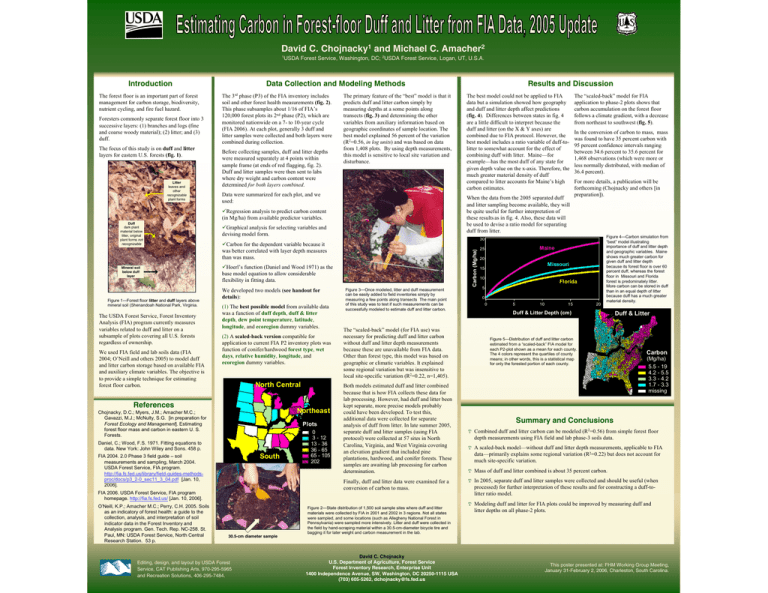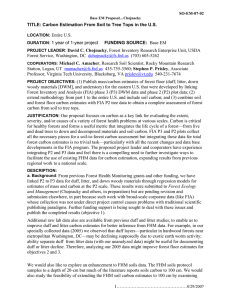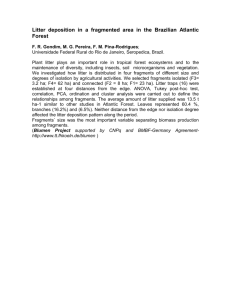David C. Chojnacky and Michael C. Amacher Results and
advertisement

David C. Chojnacky1 and Michael C. Amacher2 1USDA Introduction The forest floor is an important part of forest management for carbon storage, biodiversity, nutrient cycling, and fire fuel hazard. Foresters commonly separate forest floor into 3 successive layers: (1) branches and logs (fine and coarse woody material); (2) litter; and (3) duff. The focus of this study is on duff and litter layers for eastern U.S. forests (fig. 1). Litter leaves and other recognizable plant forms Forest Service, Washington, DC; 2USDA Forest Service, Logan, UT, U.S.A. Data Collection and Modeling Methods The 3rd phase (P3) of the FIA inventory includes soil and other forest health measurements (fig. 2). This phase subsamples about 1/16 of FIA’s 120,000 forest plots its 2nd phase (P2), which are monitored nationwide on a 7- to 10-year cycle (FIA 2006). At each plot, generally 3 duff and litter samples were collected and both layers were combined during collection. Before collecting samples, duff and litter depths were measured separately at 4 points within sample frame (at ends of red flagging, fig. 2). Duff and litter samples were then sent to labs where dry weight and carbon content were determined for both layers combined. The primary feature of the “best” model is that it predicts duff and litter carbon simply by measuring depths at a some points along transects (fig. 3) and determining the other variables from auxiliary information based on geographic coordinates of sample location. The best model explained 56 percent of the variation (R2=0.56, in log units) and was based on data from 1,408 plots. By using depth measurements, this model is sensitive to local site variation and disturbance. Data were summarized for each plot, and we used: When the data from the 2005 separated duff and litter sampling become available, they will be quite useful for further interpretation of these results as in fig. 4. Also, these data will be used to devise a ratio model for separating duff from litter. 9Regression analysis to predict carbon content (in Mg/ha) from available predictor variables. Mineral soil below duff layer Figure 1—Forest floor litter and duff layers above mineral soil (Shenandoah National Park, Virginia. The USDA Forest Service, Forest Inventory Analysis (FIA) program currently measures variables related to duff and litter on a subsample of plots covering all U.S. forests regardless of ownership. We used FIA field and lab soils data (FIA 2004; O’Neill and others 2005) to model duff and litter carbon storage based on available FIA and auxiliary climate variables. The objective is to provide a simple technique for estimating forest floor carbon. 9Graphical analysis for selecting variables and devising model form. 9Hoerl’s function (Daniel and Wood 1971) as the base model equation to allow considerable flexibility in fitting data. We developed two models (see handout for details): (1) The best possible model from available data was a function of duff depth, duff & litter depth, dew point temperature, latitude, longitude, and ecoregion dummy variables. (2) A scaled-back version compatible for application to current FIA P2 inventory plots was function of conifer/hardwood forest type, wet days, relative humidity, longitude, and ecoregion dummy variables. North Central References Northeast Chojnacky, D.C.; Myers, J.M.; Amacher M.C.; Gavazzi, M.J.; McNulty, S.G. [in preparation for Forest Ecology and Management]. Estimating forest floor mass and carbon in eastern U. S. Forests. Plots Daniel, C.; Wood, F.S. 1971. Fitting equations to data. New York: John Wiley and Sons. 458 p. South FIA 2004. 2.0 Phase 3 field guide – soil measurements and sampling, March 2004. USDA Forest Service, FIA program. http://fia.fs.fed.us/library/field-guides-methodsproc/docs/p3_2-0_sec11_3_04.pdf [Jan. 10, 2006]. 0 3 - 12 13 - 36 36 - 65 65 - 105 202 Figure 3—Once modeled, litter and duff measurement can be easily added to field inventories simply by measuring a few points along transects The main point of this study was to test if such measurements can be successfully modeled to estimate duff and litter carbon. The “scaled-back” model (for FIA use) was necessary for predicting duff and litter carbon without duff and litter depth measurements because these are unavailable from FIA data. Other than forest type, this model was based on geographic or climatic variables. It explained some regional variation but was insensitive to local site-specific variation (R2=0.22, n=1,405). Both models estimated duff and litter combined because that is how FIA collects these data for lab processing. However, had duff and litter been kept separate, more precise models probably could have been developed. To test this, additional data were collected for separate analysis of duff from litter. In late summer 2005, separate duff and litter samples (using FIA protocol) were collected at 57 sites in North Carolina, Virginia, and West Virginia covering an elevation gradient that included pine plantations, hardwood, and conifer forests. These samples are awaiting lab processing for carbon determination. Finally, duff and litter data were examined for a conversion of carbon to mass. FIA 2006. USDA Forest Service, FIA program homepage. http://fia.fs.fed.us/ [Jan. 10, 2006]. O’Neill, K.P.; Amacher M.C.; Perry, C.H. 2005. Soils as an indicatory of forest health: a guide to the collection, analysis, and interpretation of soil indicator data in the Forest Inventory and Analysis program. Gen. Tech. Rep. NC-258. St. Paul, MN: USDA Forest Service, North Central Research Station. 53 p. 30.5-cm diameter sample Editing, design, and layout by USDA Forest Service, CAT Publishing Arts, 970-295-5965 and Recreation Solutions, 406-295-7484. The “scaled-back” model for FIA application to phase-2 plots shows that carbon accumulation on the forest floor follows a climate gradient, with a decrease from northeast to southwest (fig. 5). In the conversion of carbon to mass, mass was found to have 35 percent carbon with 95 percent confidence intervals ranging between 34.6 percent to 35.6 percent for 1,468 observations (which were more or less normally distributed, with median of 36.4 percent). For more details, a publication will be forthcoming (Chojnacky and others [in preparation]). 30 9Carbon for the dependent variable because it was better correlated with layer depth measures than was mass. Carbon (Mg/ha) Duff dark plant material below litter, original plant forms not recognizable Results and Discussion The best model could not be applied to FIA data but a simulation showed how geography and duff and litter depth affect predictions (fig. 4). Differences between states in fig. 4 are a little difficult to interpret because the duff and litter (on the X & Y axes) are combined due to FIA protocol. However, the best model includes a ratio variable of duff-tolitter to somewhat account for the effect of combining duff with litter. Maine—for example—has the most duff of any state for given depth value on the x-axis. Therefore, the much greater material density of duff compared to litter accounts for Maine’s high carbon estimates. Figure 2—State distribution of 1,500 soil sample sites where duff and litter materials were collected by FIA in 2001 and 2002 in 3 regions. Not all states were sampled, and some locations (such as Allegheny National Forest in Pennsylvania) were sampled more intensively. Litter and duff were collected in the field by hand-scraping material within a 30.5-cm-diameter bicycle tire and bagging it for later weight and carbon measurement in the lab. David C. Chojnacky U.S. Department of Agriculture, Forest Service Forest Inventory Research, Enterprise Unit 1400 Independence Avenue, SW, Washington, DC 20250-1115 USA (703) 605-5262, dchojnacky@fs.fed.us Maine 25 20 Missouri 15 10 Florida 5 0 0 5 10 15 20 Figure 4—Carbon simulation from “best” model illustrating importance of duff and litter depth and geographic variables. Maine shows much greater carbon for given duff and litter depth because its forest floor is over 60 percent duff, whereas the forest floor in Missouri and Florida forest is predominately litter. More carbon can be stored in duff than in an equal depth of litter because duff has a much greater material density. Duff & Litter Depth (cm) Figure 5—Distribution of duff and litter carbon estimated from a “scaled-back” FIA model for each P2-plot shown as a mean for each county. The 4 colors represent the quartiles of county means; in other words, this is a statistical map for only the forested portion of each county. Duff & Litter Carbon (Mg/ha) 5.5 - 19 4.2 - 5.5 3.3 - 4.2 1.7 - 3.3 missing Summary and Conclusions T Combined duff and litter carbon can be modeled (R2=0.56) from simple forest floor depth measurements using FIA field and lab phase-3 soils data. T A scaled-back model—without duff and litter depth measurements, applicable to FIA data—primarily explains some regional variation (R2=0.22) but does not account for much site-specific variation. T Mass of duff and litter combined is about 35 percent carbon. T In 2005, separate duff and litter samples were collected and should be useful (when processed) for further interpretation of these results and for constructing a duff-tolitter ratio model. T Modeling duff and litter for FIA plots could be improved by measuring duff and litter depths on all phase-2 plots. This poster presented at: FHM Working Group Meeting, January 31-February 2, 2006, Charleston, South Carolina.





